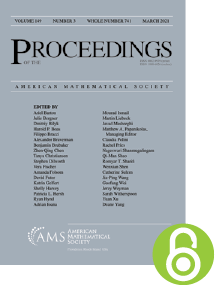The Barwise-Schlipf theorem
HTML articles powered by AMS MathViewer
- by Ali Enayat and James H. Schmerl PDF
- Proc. Amer. Math. Soc. 149 (2021), 413-416 Request permission
Abstract:
In 1975 Barwise and Schlipf published a landmark paper whose main theorem asserts that a nonstandard model $\mathcal {M}$ of $\mathsf {PA}$ (Peano arithmetic) is recursively saturated iff $\mathcal {M}$ has an expansion that satisfies the subsystem $\Delta _{1}^{1}$-$\mathsf {CA}_{0}$ of second order arithmetic. In this paper we identify a crucial error in the Barwise–Schlipf proof of the right-to-left direction of the theorem, and we offer a correct proof of the problematic direction.References
- Jon Barwise and John Schlipf, On recursively saturated models of arithmetic, Model theory and algebra (A memorial tribute to Abraham Robinson), Lecture Notes in Math., Vol. 498, Springer, Berlin, 1975, pp. 42–55. MR 0409172
- Matt Kaufmann and James H. Schmerl, Saturation and simple extensions of models of Peano arithmetic, Ann. Pure Appl. Logic 27 (1984), no. 2, 109–136. MR 763736, DOI 10.1016/0168-0072(84)90008-3
- Matt Kaufmann and James H. Schmerl, Remarks on weak notions of saturation in models of Peano arithmetic, J. Symbolic Logic 52 (1987), no. 1, 129–148. MR 877860, DOI 10.2307/2273867
- Roman Murawski, On expandability of models of Peano arithmetic. I, Studia Logica 35 (1976), no. 4, 409–419. MR 441723, DOI 10.1007/BF02123406
- Stephen G. Simpson, Subsystems of second order arithmetic, Perspectives in Mathematical Logic, Springer-Verlag, Berlin, 1999. MR 1723993, DOI 10.1007/978-3-642-59971-2
- C. Smoryński, Recursively saturated nonstandard models of arithmetic, J. Symbolic Logic 46 (1981), no. 2, 259–286. MR 613281, DOI 10.2307/2273620
Additional Information
- Ali Enayat
- Affiliation: University of Gothenburg, Gothenburg, Sweden
- MR Author ID: 63375
- ORCID: 0000-0003-0372-3354
- Email: ali.enayat@gu.se
- James H. Schmerl
- Affiliation: University of Connecticut, Storrs, Connecticut 06269
- MR Author ID: 156275
- ORCID: 0000-0003-0545-8339
- Email: james.schmerl@uconn.edu
- Received by editor(s): November 10, 2019
- Received by editor(s) in revised form: May 24, 2020
- Published electronically: October 20, 2020
- Additional Notes: The authors are grateful to Roman Kossak, Mateusz Łełyk, and an anonymous referee for their help in improving the paper’s exposition.
- Communicated by: Heike Mildenberger
- © Copyright 2020 American Mathematical Society
- Journal: Proc. Amer. Math. Soc. 149 (2021), 413-416
- MSC (2010): Primary 03C50, 03C62, 03H15
- DOI: https://doi.org/10.1090/proc/15216
- MathSciNet review: 4172616


